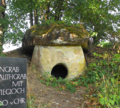Horgen culture
| Geographical range | Southern Germany and Switzerland near Lake Constance, Rhine river basin. |
|---|---|
| Period | Later Neolithic, Chalcolithic |
| Dates | 3,500–2,850 BC |
| Characteristics | simple pottery, well-developed stone tools, lake shore settlements |
| Preceded by | Pfyn culture, Cortaillod culture |
| Followed by | Corded Ware culture, Bell Beaker culture |
The Horgen culture is one of several archaeological cultures belonging to the Neolithic period of Switzerland. The Horgen culture may derive from the Pfyn culture and early Horgen pottery is similar to the earlier Cortaillod culture pottery of Twann, Switzerland.[1] It is named for one of the principal sites, in Horgen, Switzerland.
Dates

The Horgen culture started around 3500/3400 cal BC and lasted until 2850 cal BC. Tree ring dates range from 3370 – 2864 BC.[1]
Distribution
The Horgen core area is in Northern Switzerland and Southwest Germany near
At Feldmeilen-Vorderfeld and Meilen on the right bank of Lake Zurich near Zürich, four layers of Pfyn culture artifacts (4350-3950 BC calibrated) are followed by five Horgen culture (3350-2950 BC) layers were found at Feldmeilen. In nearby Meilen, one Pfyn layer (4250-4000 BC) followed by three Horgen (3300-2500 BC) layers were discovered.[3]
Traits
There were three phases of pottery; early, middle, and late. The early pottery exhibits an affinity with the Pfyn and maybe the Cortaillod at Twann, Switzerland. The spindle whorls on the pottery may indicate connections to the southern Funnelbeaker culture and early Baden culture. The middle phase (found at Naschdorf-Strandbad, Lake Constance and Dullenried, Federsee) may be influenced by more westerly traditions. The final Horgen phase exhibits similarities to the Burgerroth, Wartberg, and Goldberg III cultures.[1]
The pottery was less refined and decorated than the earlier Cortaillod culture. However, the flint industry was well developed and produced elegant stone tools.[2]
Pigs became increasingly important during the Horgen era. Pig bones were the most common bones found in the village midden heaps, accounting for up to 70% of all bones.[4]
The Horgen culture practiced copper smelting to a limited extent, though copper finds are rare and evidence of processing is sporadic.[5] Ötzi the iceman, who was found with a copper axe, also had stone tools of Horgen culture type.[6]
Gallery

-
Wooden wheel fragment, c. 3000 BC[7]
-
Alpine copper axe, 4th millennium BC
See also
- Schwörstadt-type dolmen
- Prehistoric pile dwellings around the Alps
- Prehistoric pile dwellings around Lake Zurich
References
- ^ a b c d Comparative Archeology Web Archived 2010-11-02 at the Wayback Machine accessed 28 June 2010
- ^ ISBN 978-0-936923-08-6. Retrieved 28 June 2010.
- ISBN 978-0-520-03680-2. Retrieved 7 July 2010.
- ISBN 978-0-415-31719-1. Retrieved 28 June 2010.
- ^ ielsen, Ebbe (2016). "Neolithic Copper Artefacts from the Canton of Lucerne (Central Switzerland)". Archaologisches Korrespondenzblatt. 46 (2): 149–165.
During the late Neolithic Horgen Culture (approx. 3300-2800 BC), copper fnds are rare in eastern and central Switzerland, and evidence of processing is only sporadically established.
- PMID 29924811.
- .













![Wooden wheel fragment, c. 3000 BC[7]](http://upload.wikimedia.org/wikipedia/commons/thumb/4/4a/Landesmuseum_W%C3%BCrttemberg_Stuttgart_Neolithikum_156.jpg/120px-Landesmuseum_W%C3%BCrttemberg_Stuttgart_Neolithikum_156.jpg)
